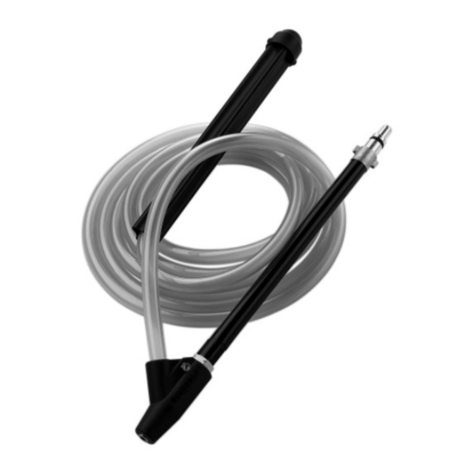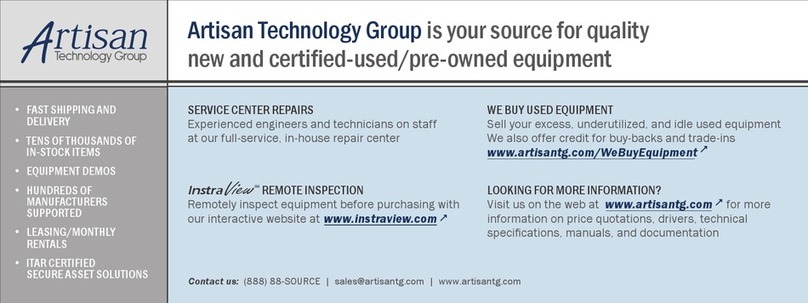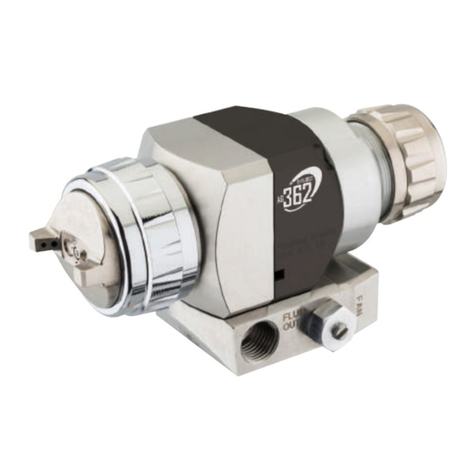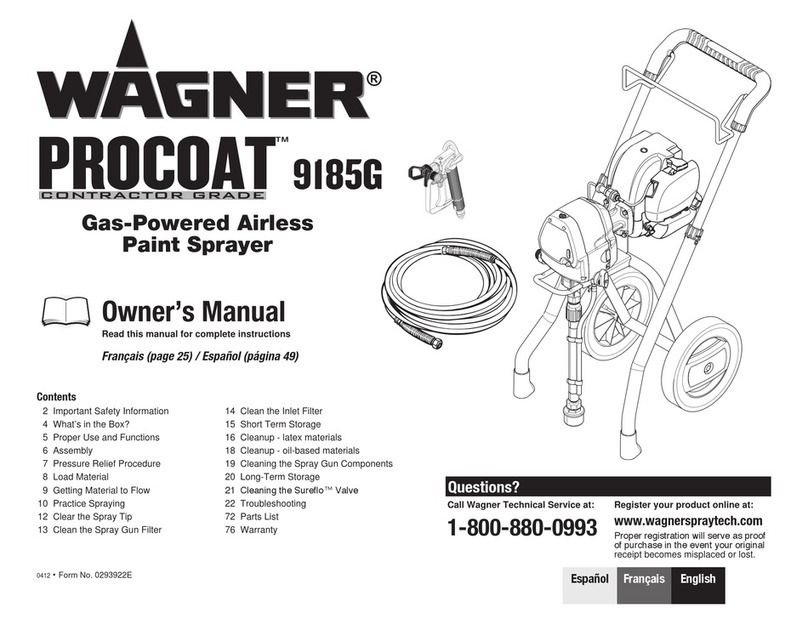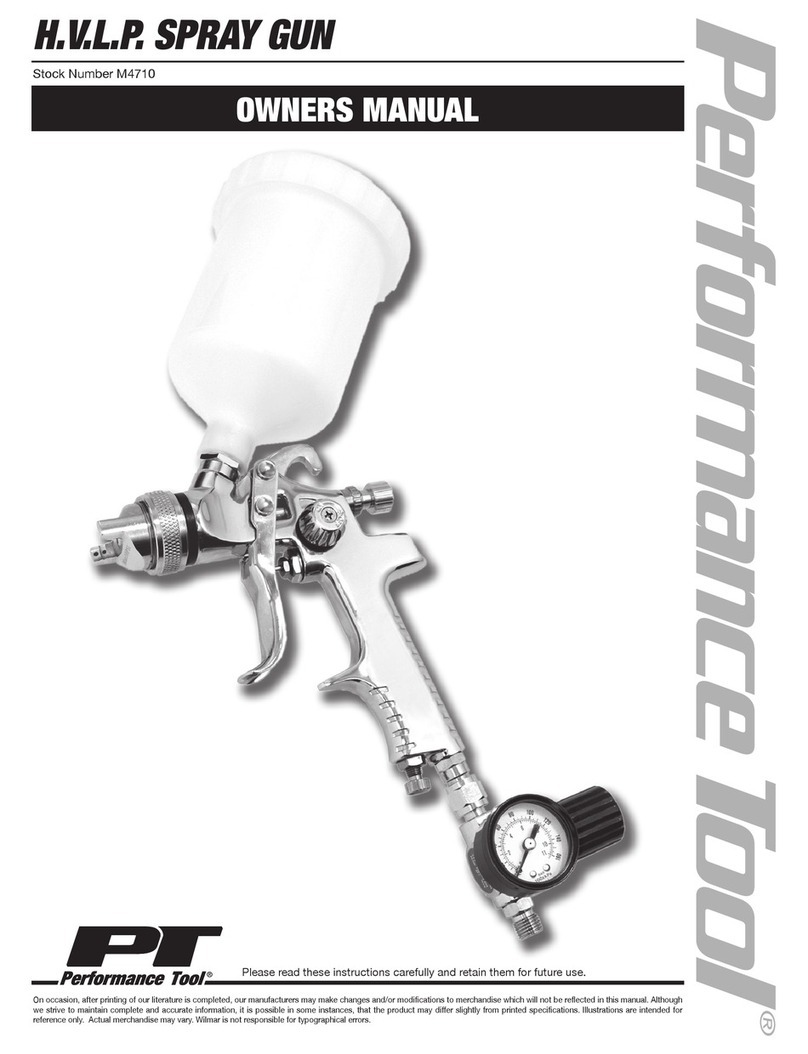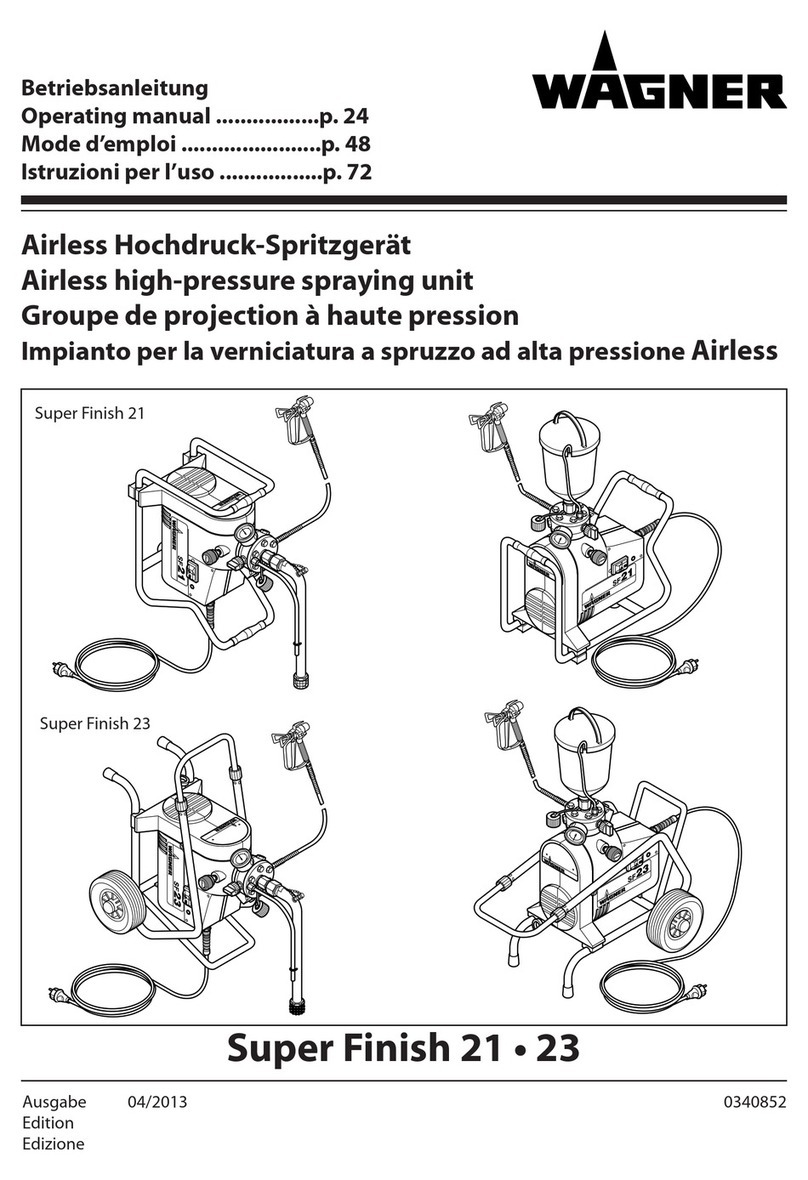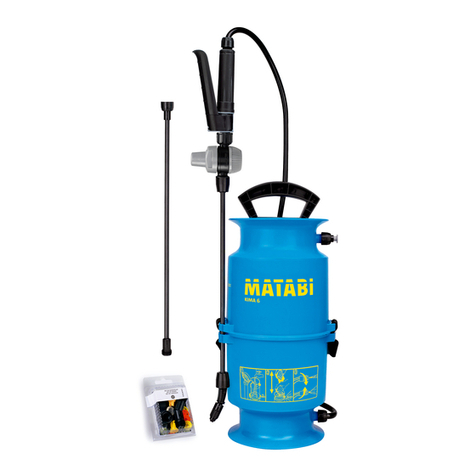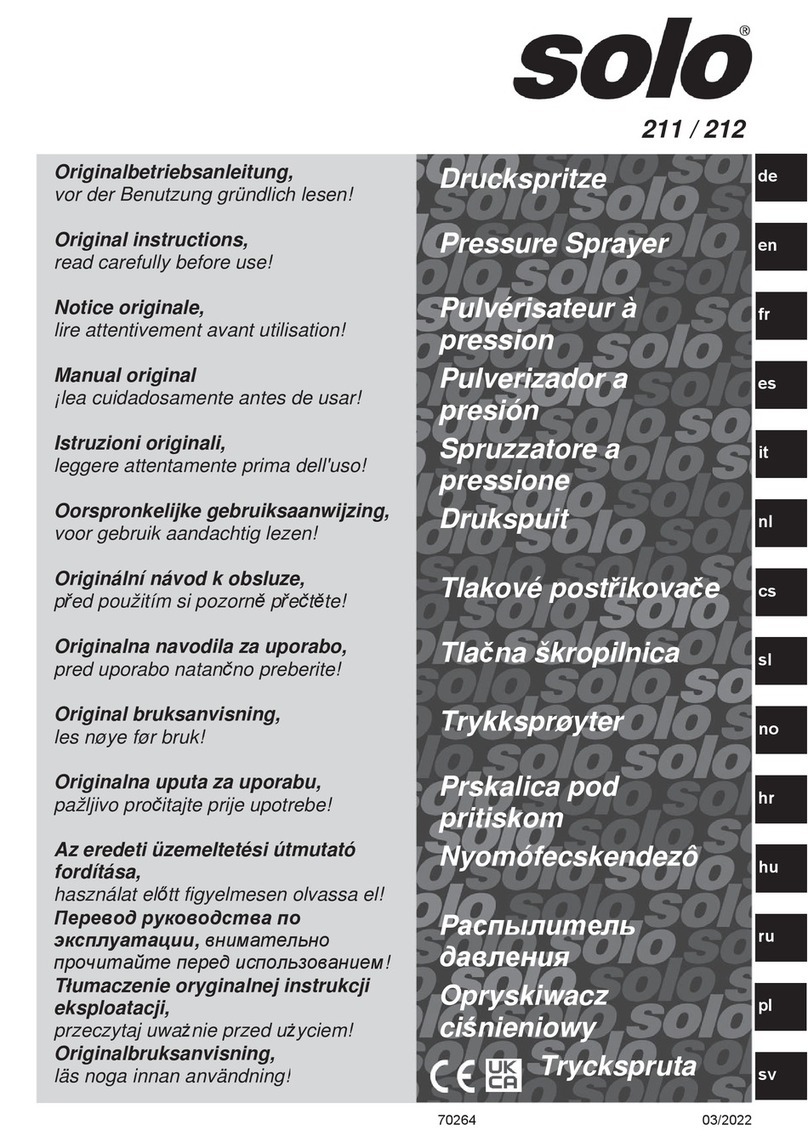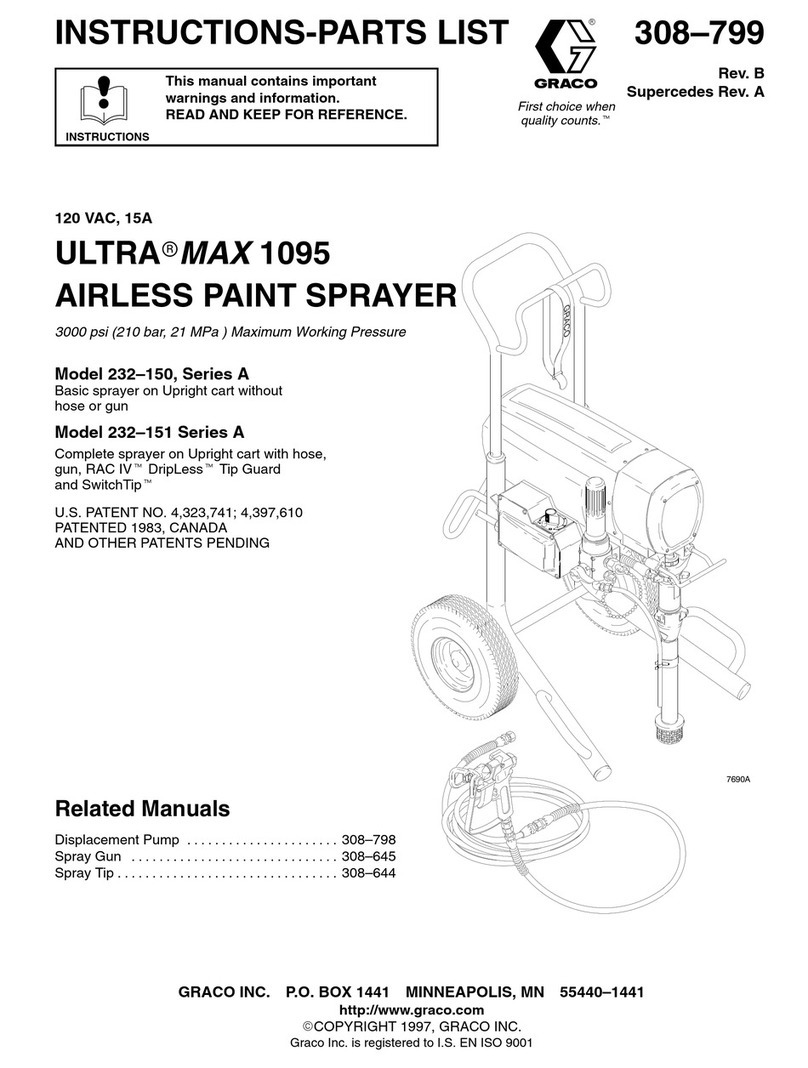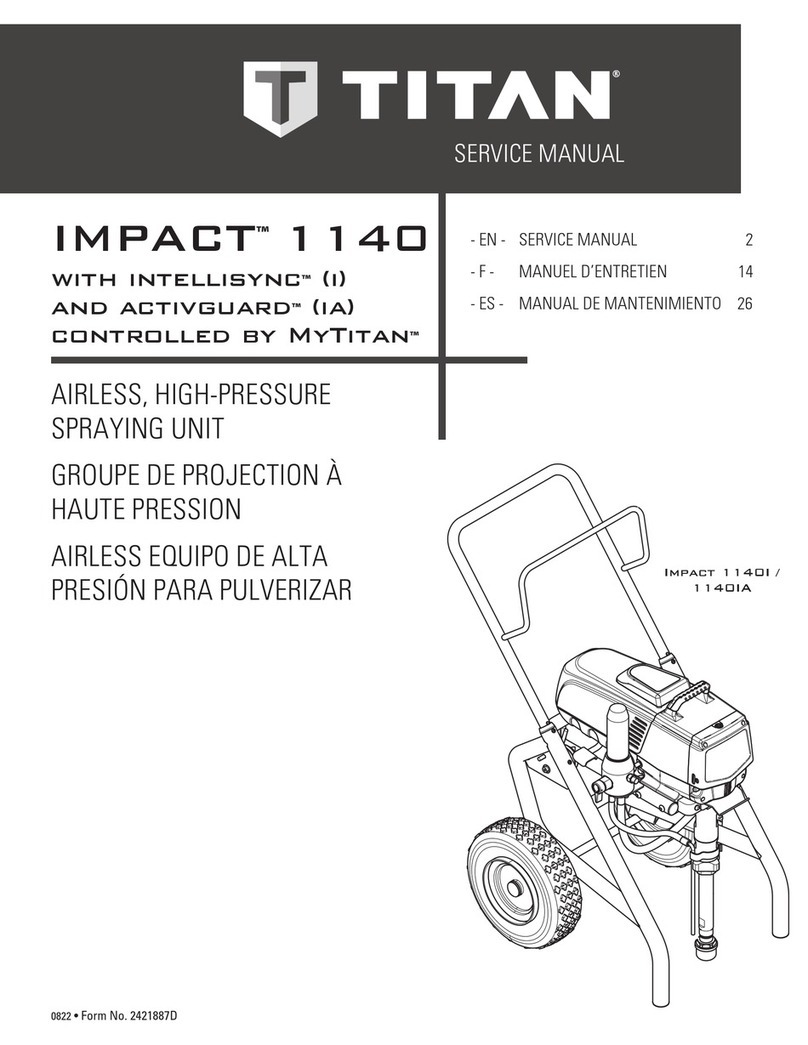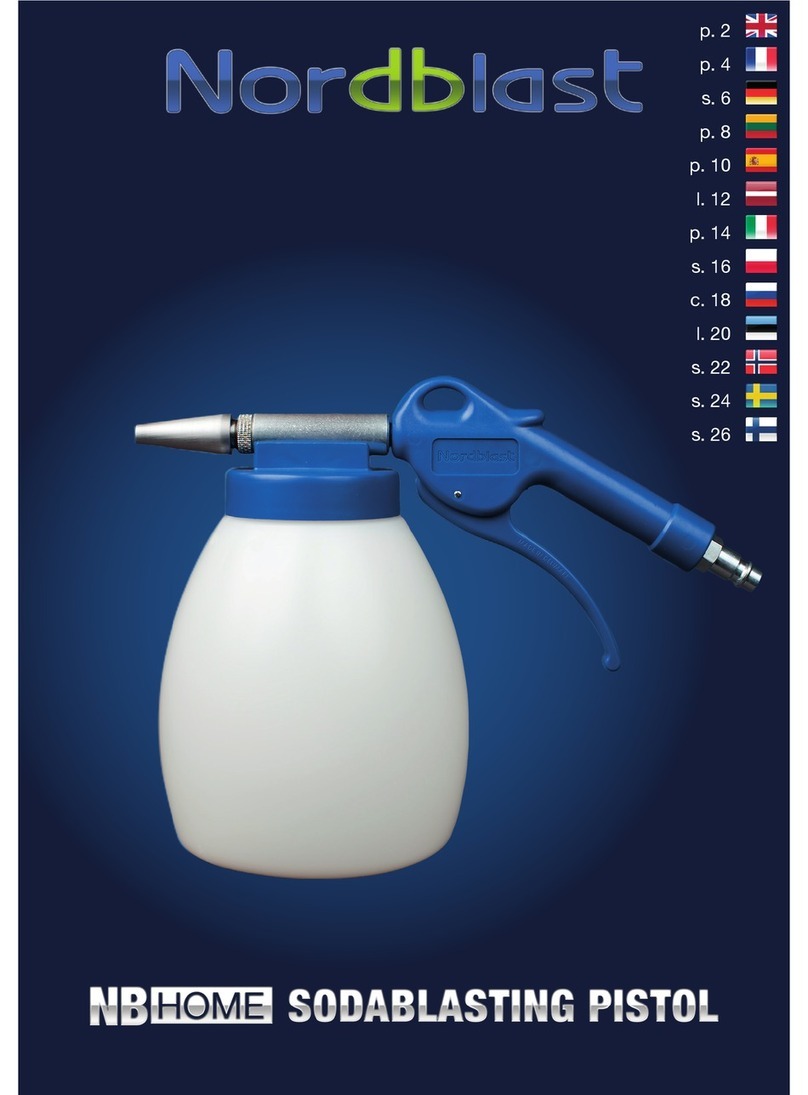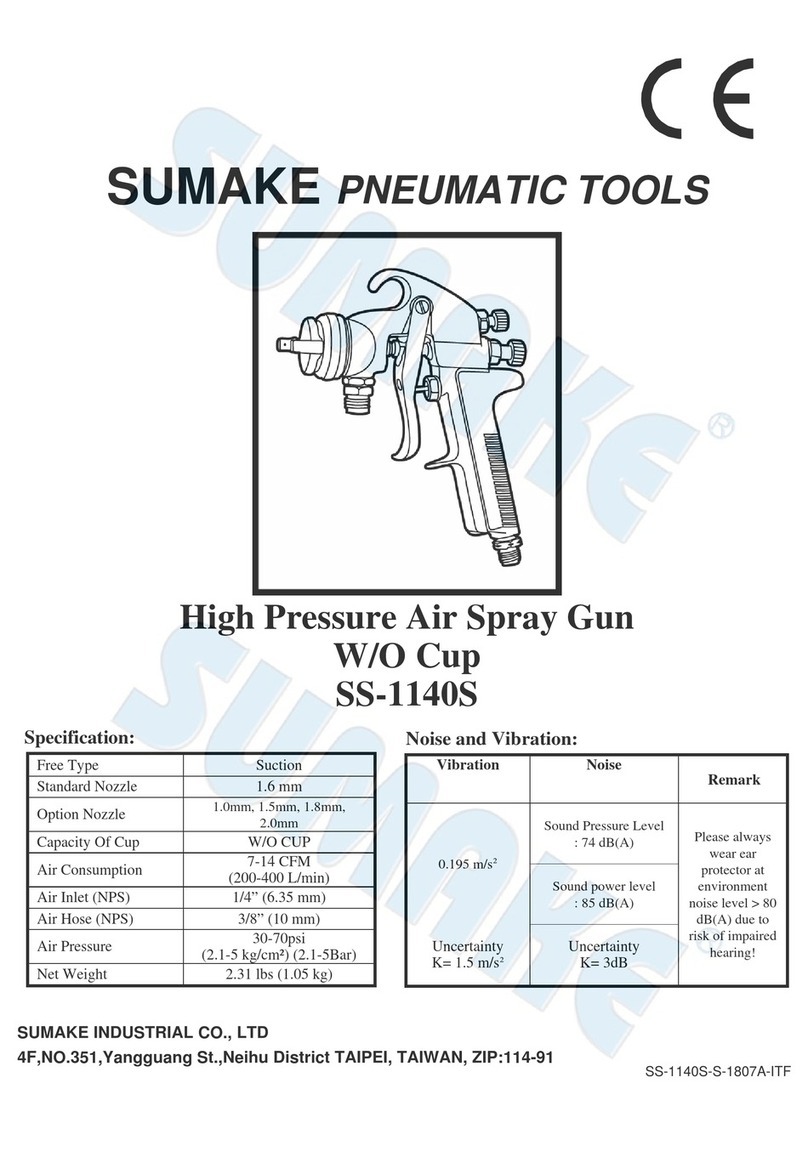Storm Machinery 5008 Troubleshooting guide

Important Safety Instructions
Read all warnings and instructions in this manual.
Do not proceed until you fully understand its contents
These WARNINGS are included for the health and safety of
the operator and those in the immediate vicinity.
Save these instructions.
5008 Conventional
Spray Gun
1
torm
machinery
strictly
superior
TM
Storm Machinery
www.stormmachinery.co.za
sales@stormmachinery.co.za
Operating Instructions & Service Manual

GRAVITY FEED SPRAY GUN
The following instructions provide the necessary
information for the proper maintenance of the
Airpro Gravity feed spray gun. Please read and
understand all the information in this document
in order to get the maximum performance from
your new AM5008HVLP spray gun.
The AM5008HVLP spray gun is the result of quality
engineering and development activity. The
result is an ergonomic product with reduced
triggering effort and fine atomization. The
specification table details the operating
parameters of the gun.
The AM5008HVLP spray gun should be operated under
the safety directions outlined in this literature.
Your safety and the safety of others depend
on your thorough understanding of the
material contained herein.
If you have any questions or do not
understand the content in this literature,
call your nearest service representative.
SPECIFICATIONS
Max. Air Pressure: 43psi/3bar
Gun Body: Cast Aluminum
Fluid Path: Stainless Steel
Fluid Nozzle: Stainless Steel
Fluid Needle: Stainless Steel
Air Inlet Size; 1/4" NPS(M)
Gun Weight: 430 g
AM5008HVLP @29 psi 10 cfm
Air Consumption:
2

LOCK OUT / TAG-OUT
Failure to de-energize, disconnect, lock out and tag-out
all power sources before performing equipment maintenance
could cause serious injury or death.
OPERATOR TRAINING
All personnel must be trained before operating finishing
equipment.
EQUIPMENT MISUSE HAZARD
Equipment misuse can cause the equipment to rupture,
malfunction, or start unexpectedly and result in serious injury.
PROJECTILE HAZARD
You may be injured by venting liquids or gases that are released
under pressure, or flying debris.
PINCH POINT HAZARD
Moving parts can crush and cut. Pinch points are basically any areas
where there are moving parts.
INSPECT THE EQUIPMENT DAILY
Inspect the equipment for worn or broken parts on a daily
basis. Do not operate the equipment if you are uncertain
about its condition.
Hazards or unsafe practices which
could result in minor personal
injury, product or property damage.
!
CAUTION
Hazards or unsafe practices which
could result in severe personal
injury, death or substantial
property damage.
!
WARNING
Important installation, operation
or maintenance information.
NOTE
Read the following warnings before using this equipment.
READ THE MANUAL
Before operating finishing equipment, read and understand
all safety, operation and maintenance information provided
in the operation manual.
WEAR SAFETY GLASSES
Failure to wear safety glasses with side shields could result
in serious eye injury or blindness.
NEVER MODIFY THE EQUIPMENT
Do not modify the equipment unless the manufacturer provides
written approval.
IT IS THE RESPONSIBILITY OF THE EMPLOYER TO PROVIDE THIS INFORMATION TO THE OPERATOR OF THE EQUIPMENT.
KNOW WHERE AND HOW TO SHUT OFF THE EQUIPMENT
IN CASE OF AN EMERGENCY
PRESSURE RELIEF PROCEDURE
Always follow the pressure relief procedure in the equipment
instruction manual.
NOISE HAZARD
You may be injured by loud noise. Hearing protection may be
required when using this equipment.
STATIC CHARGE
Fluid may develop a static charge that must be dissipated through proper
grounding of the equipment, objects to be sprayed and all other electrically
conductive objects in the dispensing area. Improper grounding or sparks
can cause a hazardous condition and result in fire, explosion or electric
shock and other serious injury.
PROP 65 WARNING
WARNING: This product contains chemicals known to the State
of California to cause cancer and birth defects or other
reproductive harm.
WEAR RESPIRATOR
Toxic fumes can cause serious injury or death if inhaled.
Wear a respirator as recommended by the fluid and solvent
manufacturer’s Material Safety Data Sheet.
TOXIC FLUID & FUMES
Hazardous fluid or toxic fumes can cause serious injury or death if
splashed in the eyes or on the skin, inhaled, injected or swallowed.
LEARN and KNOW the specific hazards or the fluids you are using.
Follow the requirements of the Material Safety Data Sheet
supplied by your coating material manufacturer.
KEEP EQUIPMENT GUARDS IN PLACE
Do not operate the equipment if the safety devices have been
removed.
!
WARNING
AUTOMATIC EQUIPMENT
Automatic equipment may start suddenly without warning.
FIRE AND EXPLOSION HAZARD
Improper equipment grounding, poor ventilation, open flame or sparks
can cause a hazardous condition and result in fire or explosion and
serious injury. Halogenated hydrocarbon solvents - for example;
methylene chloride and 1, 1, 1 - Trichloroethane are not chemically
compatible with the aluminum that might be used in many system
components. The chemical reaction caused by these solvents reacting
with aluminum can become violent and lead to an equipment explosion.
MEDICAL ALERT
Any injury caused by high pressure liquid can be serious. If you are
injured or even suspect an injury:
• Go to an emergency room immediately.
• Tell the doctor you suspect an injection injury.
• Show the doctor this medical information or the medical alert
card provided with your airless spray equipment.
• Tell the doctor what kind of fluid you were spraying or
dispensing.
GET IMMEDIATE MEDICAL ATTENTION
To prevent contact with the fluid, please note the following:
• Never point the gun/valve at anyone or any part of the body.
• Never put hand or fingers over the spray tip.
• Never attempt to stop or deflect fluid leaks with your hand,
body, glove or rag.
• Always have the tip guard on the spray gun before spraying.
• Always ensure that the gun tri-gger safety operates before
spraying.
Cumulative Trauma Disorders (CTD's) CTD's, or musculoskeletal disorders, involve damage to the hand, involve loss of manual dexterity, and nonspecific pain the hands, wrists
elbows, shoulders, neck and back. Carpal tunnel syndrome and tendinitis (such as tennis elbow or rotor cuff syndrome) are examples of CTD's. CTD's can also be caused by
such activities as sewing, golf, tennis and bowling, to name a few. Pain, tingling, or numbness in the shoulder, forearm, wrist, hands or fingers, especially during the night,
may be early symptoms of a CTD. Do not ignore them. Should you experience any such symptoms, see a physician immediately. Other early symptoms may include vague
discomfort in the in the arm. Ignoring early symptoms and continued repetitive use of the arm, wrist and hand can lead to serious disability.
3

TROUBLESHOOTING
CONDITION CAUSE CORRECTION
Heavy top or
bottom pattern
Heavy right or left
side pattern
Heavy center pattern
Split spray pattern
Jerky or fluttering spray
Unable to get round spray
Will not spray
Runs and sags
Starved spray pattern
Excessive overspray
Excessive fog
Dry spray
Fluid leaking from packing nut
Fluid leaking or dripping from
front of gun
Horn holes plugged.
Obstruction on top or bottom of fluid tip.
Cap and/or tip seat dirty.
Left or right side horn holes plugged.
Dirt on left or right side of fluid tip.
Remedies for the top-heavy, bottom-heavy, right-heavy, and left-heavy patterns:
1. Determine if the obstruction is on the air cap or the fluid tip. Do this by making a test spray
pattern. Then, rotate the cap one-half turn and spray another pattern. If the defect is inverted,
obstruction is on the air cap. Clean the air cap as previously instructed.
2. If the defect is not inverted, it is on the fluid tip. Check for a fine burr on the edge of the fluid
tip. Remove with #600 wet or dry sand paper. or replace fluid tip
3. Check for dried paint just inside the opening; remove by washing with solvent.
Clean. Ream with non-metallic point.
Clean.
Clean.
Clean. Ream with non-metallic point.
Clean.
Fluid flow too high for atomization air.
(Pressure Feed)
Material flow exceeds air cap's capacity.
Spreader adjustment valve set too low.
Atomizing pressure too low.
Material too thick.
Atomization air pressure too high.
Fluid flow too low.
Spreader adjusting valve set too high.
*Loose or damaged fluid tip/seat.
Material level too low.
Container tipped too far.
Obstruction in fluid passage.
Dry or loose fluid needle packing nut.
Loose or broken fluid tube or fluid inlet nipple.
Spreader adjustment screw not seating
properly.
Air cap retaining ring loose.
No air pressure at gun.
Fluid needle adjusting screw not open enough.
Fluid too heavy for gravity feed.
Fluid pressure too low.
Too much material flow.
Material too thin.
Gun tilted on an angle or gun motion too slow.
Inadequate material flow.
Low atomization air pressure (suction feed).
Too much atomization air pressure.
Gun too far from work surface.
Improper stroking (arcing, gun motion too
fast).
Too much or too fast-drying thinner.
Too much atomization air pressure.
Air pressure too high.
Gun tip too far from work surface.
Gun motion too fast.
Gun out of adjustment.
Packing nut loose.
Packing worn or dry.
Packing nut too tight.
Dry packing.
Fluid tip or needle worn or damaged.
Foreign matter in tip.
Fluid needle spring broken.
Wrong size needle or tip.
Balance air pressure and fluid flow. Increase
spray pattern width with spreader adjustment
valve.
Thin or lower fluid flow.
Adjust.
Increase pressure.
Thin to proper consistency.
Reduce at compressor or gun.
Increasefluid flow (increasesgunhandlingspeed).
Adjust.
Tighten or replace.
Refill.
Hold more upright.
Backflush with solvent.
Lubricate or tighten.
Tighten or replace.
Clean or replace.
Tighten.
Check air supply and air lines, blow out gun air
passages.
Open fluid needle adjusting screw.
Thin material and/or change to larger tip size.
Increase fluid pressure at tank.
Adjust gun or reduce fluid pressure.
Mix properly or apply light coats.
Hold gun at right angle to work and adapt to
proper gun technique.
Back fluid adjusting screw out to first thread,
or increase fluid pressure at tank.
Increase air pressure and rebalance gun.
Reduce pressure.
Adjust to proper distance.
Move at moderate pace, parallel to work
surface.
Remix properly.
Reduce pressure.
Reduce air pressure.
Adjust to proper distance.
Slow down.
Adjust.
Tighten, do not bind needle.
Replace or lubricate.
Adjust.
Lubricate.
Replace tip and needle with lapped sets.
Clean.
Replace.
Replace.
*Most common problems.
4

AIR PRESSURE
Atomizing pressure must be set properly
to allow for the drop in air pressure between
the regulator and the spray gun.
Separator filter is important.
Achieving a fine spray finish without the use of a good separator filter is virtually
impossible
A regulator / separator filter serves a double purpose. It eliminates blistering
and spotting by keeping air free of oil and water, and it gives precise air pressure
control at the gun.
OPERATION AND MAINTENANCE FOR AM5008 SPRAY GUN
Your new AM5008 spray gun is
exceptionally rugged in construction and
is built to stand up under hard, continuous
use. However, like any other fine precision
instrument, its most efficient operation
depends ona knowledge of its contruction,
operation and maintenance. Properly
handled and cared for, it will produce
beautiful, uniform finishing results long
after other spray guns have worn out.
SET-UP FOR SPRAYING
Connecting Gun To Air Hose
Air should be supplied by a suitable length
of 5/16"or larger diameter air hose fitted
with a 1/4" NPS(f) connection at gun end.
For hose lengths over 50', use 3/8"
diameter hose.
SPRAY GUN CLEANING
INSTRUCTIONS
In certain states it is now against the
law to spray solvents containing Volatile
Organic Compounds (VOC)’s into the
atmosphere when cleaning a spray
gun.
In order to comply with these air quality
laws Storm recommends one of the
following two methods to clean your
spray finishing equipment:
1. Spray solvent through the gun into a
closed system. An enclosed unit or
spray gun cleaning station condenses
solvent vapors back into liquid form
which prevents escape of VOC’s
into the atmosphere.
2. Place spray gun in a washer type
cleaner. This system must totally
enclose the spray gun, cups, nozzles
and other parts during washing, rinsing
and draining cycles. This type of unit
must be able to flush solvent through
the gun without releasing any VOC
vapors into the atmosphere.
Additionally, open containers for storage
or disposal of solvent or solvent containing
cloth or paper used for surface preparation
and clean-up may not be used. All
containers shall be nonabsorbent.
Pointers On Cleaning
Unscrew, empty and carefully rinse cup
out with thinners. Place clean thinners
in the cup and spray this through the
gun until it is clean. Blow air through
gun to dry it.
All parts on a spray gun should be
screwed in hand tight at first; this
will avoid the possibility of cross
threading the parts. If the parts
cannot be turned by hand easily,
make sure you have the correct parts,
unscrew, realign, and try again.
NEVER use undue force in mating
parts.
!
CAUTION
5

SPRAY TECHNIQUE
The first requirement for a good resultant
finish is the proper handling of the gun.
The gun should be held perpendicular to
the surface being covered and moved
parallel with it. The stroke should be
started before the trigger is pulled and
the trigger should be released before the
stroke is ended. This gives accurate control
of the gun and fluid.
The distance between gun and surface
should be 15 to 20 cm depending on
fluid and atomizing pressure. The fluid
deposited should always be even and
wet. Lap each stroke over the preceding
stroke to obtain a uniform finish. Use
50% overlap.
GENERAL SPRAY
INSTRUCTIONS
Strain material thru 60 or 90 mesh screen.
To reduce overspray and obtain maximum
efficiency, always spray with the lowest
possible fluid/air pressure that produces
an acceptable spray pattern.
Excessive atomizing air pressures can
increase overspray, reduce transfer
efficiency, and with some materials,
result in poor finish quality from
dry spray.
Generally use 30 psi air at gun inlet.
Unusually heavy, difficult to
atomize fluids may require up to 40 psi air
at gun inlet.
CONTROLLING THE FAN SPRAY
The fan spray is controlled by means of the
spray pattern valve. Turning this control
clockwise until it is closed will give a round
spray; turning it counterclockwise will widen
the spray into a fan shape. The fan spray
can be turned anywhere through 360 ° by
positioning the air nozzle relative to the gun.
To accomplish this, loosen retaining ring,
position nozzle, then tighten retaining ring.
AIR NOZZLE, FLUID NOZZLE,
FLUID NEEDLE
1. All nozzles and needles are precision
made. They should be handled with
care.
2. Do not make any alterations in the gun.
To do so could cause finishing
difficulties.
3. To clean nozzles, soak them in solvent to
dissolve any dried material, then blow
them clean with air.
4. Do not probe any of the holes in the
nozzles with metal instruments. If probing
is necessary, use only a tool that is softer
than brass.
TROUBLESHOOTING
Faulty Spray
A faulty spray pattern is often caused by improper
cleaning resulting in dried materials around the
fluid nozzle tip or in the air nozzle. Soak these
parts in thinners to soften the dried material
and remove with a brush or cloth.
If either the air nozzle or fluid nozzle are
damaged, these parts must be replaced
before perfect spray can be obtained.
When replacing the fluid tip or fluid needle,
replace both at the same time. Using worn
parts can cause fluid leakage. Also, replace
the needle packing at this time. Lightly
lubricate the threads of the fluid tip before
reassembling.
Intermittent Spray
If the spray flutters, it is caused by one of the
following faults:
1. Insufficient fluids available. Check supply
and replenish if necessary.
2. Fluid tip not tightened sufficiently.
3. Packing loose or worn.
NOTE
To reduce overspray and obtain
maximum efficiency always spray
with the lowest possible atomizing
air pressure.
CAUTION
Never use metal instruments to
clean the air or fluid nozzles.
These parts are carefully
machined and any damage to
them will cause faulty spray.
!
OPERATING THE 905
SPRAY GUN
AIRPRO AM5008 GRAVITY FEED SPRAY GUN
6

7

Storm Machinery Standard Warranty
Storm Machinery warrants all equipment referenced in this document which is manufactured by Storm Machinery and bearing its name
to be free from defects in material and workmanship on the date of sale to the original purchaser for use. With the exception of any
special, extended, or limited warranty published by Storm Machinery, Storm Machinery will, for a period of twelve months from the date
of sale, repair or replace any part of the equipment determined by Storm Machinery to be defective. This warranty applies only when
the equipment is installed, operated and maintained in accordance with Storm Machinery’s written recommendations.
This warranty does not cover, and Storm Machinery shall not be liable for general wear and tear, or any malfunction, damage or wear
caused by faulty installation, misapplication, abrasion, corrosion, inadequate or improper maintenance, negligence, accident,
tampering, or substitution of non-Storm Machinery component parts. Nor shall Storm Machinery be liable for malfunction, damage or
wear caused by the incompatibility of Storm Machinery equipment with structures, accessories, equipment or materials not supplied by
Storm Machinery, or the improper design, manufacture, installation, operation or maintenance of structures, accessories, equipment or
materials not supplied by Storm Machinery.
This warranty is conditioned upon the prepaid return of the equipment claimed to be defective to an authorized Storm Machinery
distributor for verification of the claimed defect. If the claimed defect is verified, Storm Machinery will repair or replace free of charge
any defective parts. The equipment will be returned to the original purchaser transportation prepaid. If inspection of the equipment does
not disclose any defect in material or workmanship, repairs will be made at a reasonable charge, which charges may include the costs
of parts, labour, and transportation.
THIS WARRANTY IS EXCLUSIVE, AND IS IN LIEU OF ANY OTHER WARRANTIES, EXPRESS OR IMPLIED, INCLUDING BUT NOT
LIMITED TO WARRANTY OF MERCHANTABILITY OR WARRANTY OF FITNESS FOR A PARTICULAR PURPOSE.
Storm Machinery’s sole obligation and buyer’s sole remedy for any breach of warranty shall be as set forth above. The buyer agrees
that no other remedy (including, but not limited to, incidental or consequential damages for lost profits, lost sales, injury to person or
property, or any other incidental or consequential loss) shall be available. Any action for breach of warranty must be brought within one
(1) year of the date of sale.
Storm Machinery MAKES NO WARRANTY, AND DISCLAIMS ALL IMPLIED WARRANTIES OF MERCHANTABILITY AND
FITNESS FOR A PARTICULAR PURPOSE, IN CONNECTION WITH ACCESSORIES, EQUIPMENT, MATERIALS OR
COMPONENTS SOLD BUT NOT MANUFACTURED BY Storm Machinery.
These items sold, but not manufactured by Storm Machinery (such as electric motors, switches, hose, etc.), are subject to the warranty,
if any, of their manufacturer. Storm Machinery will provide purchaser with reasonable assistance in making any claim for breach of these
warranties.
In no event will Storm Machinery be liable for indirect, incidental, special or consequential damages resulting from Storm Machinery
supplying equipment hereunder, or the furnishing, performance, or use of any products or other goods sold hereto, whether due to a
breach of contract, breach of warranty, the negligence of Storm Machinery, or otherwise.
FOR NON-ENGLISH SPEAKING CUSTOMERS
The Parties acknowledge that they have required that the present document, as well as all documents, notices and legal proceedings
entered into, given or instituted pursuant hereto or relating directly or indirectly hereto, be drawn up in English.
FRENCH
Les parties reconnaissent avoir convenu que la rédaction du présente document sera en Anglais, ainsi que tous documents, avis et
procédures judiciaires exécutés, donnés ou intentés, à la suite de ou en rapport, directement ou indirectement, avec les procédures
concernées.
SPANISH
Las partes reconocen haber convenido en que la redacción de este documento será en Inglés, así como todos los documentos,
notificaciones y procedimientos judiciales emprendidos, dados o incoados como consecuencia de o en relación directa o
indirectamente con los procedimientos pertinentes.
PORTUGUESE
As partes reconhecem que eles concordaram que a elaboração deste documento será em Inglês, bem como todos os documentos,
notas e processos legais inseridos, atribuídos ou instituídos, como resultado de ou em conexão direta ou indiretamente com os
procedimentos pertinentes.
ARABIC
ﻱﻉﺕﺭﻑﺍﻝﻁﺭﻑﺍﻥﺃﻥﻩﻡﺍﺍﺕﻑﻕﺍﻉﻝﻯﺃﻥﺹﻱﺍﻍﺓﻩﺫﻩﺍﻝﻭﺙﻱﻕﺓﺱﻭﻑﺕﻙﻭﻥﺏﺍﻝﻝﻍﺓﺍﻝﺇﻥﺝﻝﻱﺯﻱﺓ٬ﻭﻙﺫﻝﻙﺝﻡﻱﻉﺍﻝﻭﺙﺍﺉﻕﻭﺍﻝﺇﺵﻉﺍﺭﺍﺕﻭﺍﻝﺇﺝﺭﺍءﺍﺕ
ﺍﻝﻕﺍﻥﻭﻥﻱﺓﺍﻝﺕﻱﺃﺏﺭﻡﺕ٬ﻡﻉﻱﻥﺃﻭﻭﺽﻉﺕﻥﺕﻱﺝﺓﺃﻭﻑﻱﻡﺍﻱﺕﻉﻝﻕﺏﺹﻭﺭﺓﻡﺏﺍﺵﺭﺓﺃﻭﻍﻱﺭﻡﺏﺍﺵﺭﺓﻡﻉﺍﻝﺇﺝﺭﺍءﺍﺕﺫﺍﺕﺍﻝﺹﻝﺓ.
TO PLACE AN ORDER, please contact your nearest Storm Machinery distributor.
www.stormmachinery.com.au
www.stormachinery.co.za
All written and visual data contained in this document reflects the latest product information available at the time of publication.
Storm Machinery reserves the right to make changes at any time without notice.
8
Table of contents
